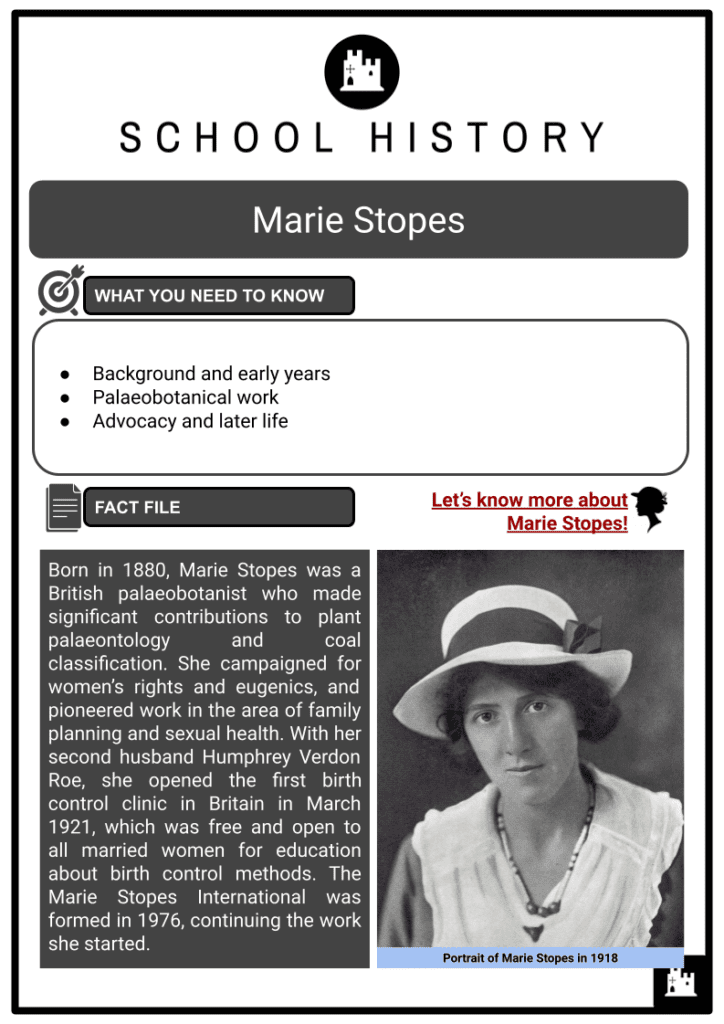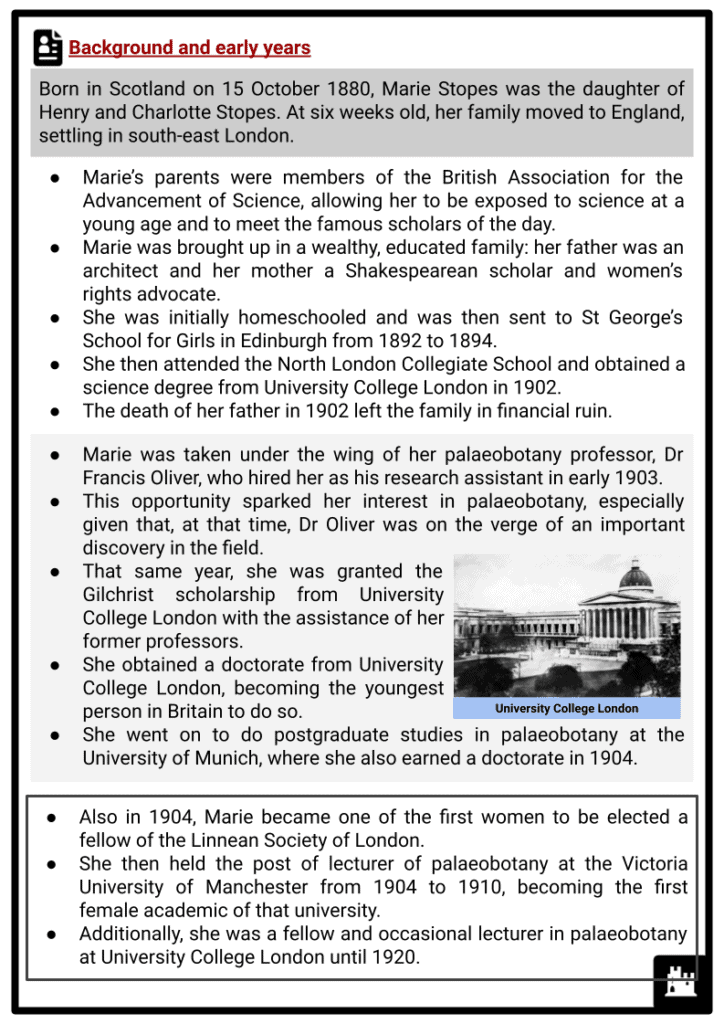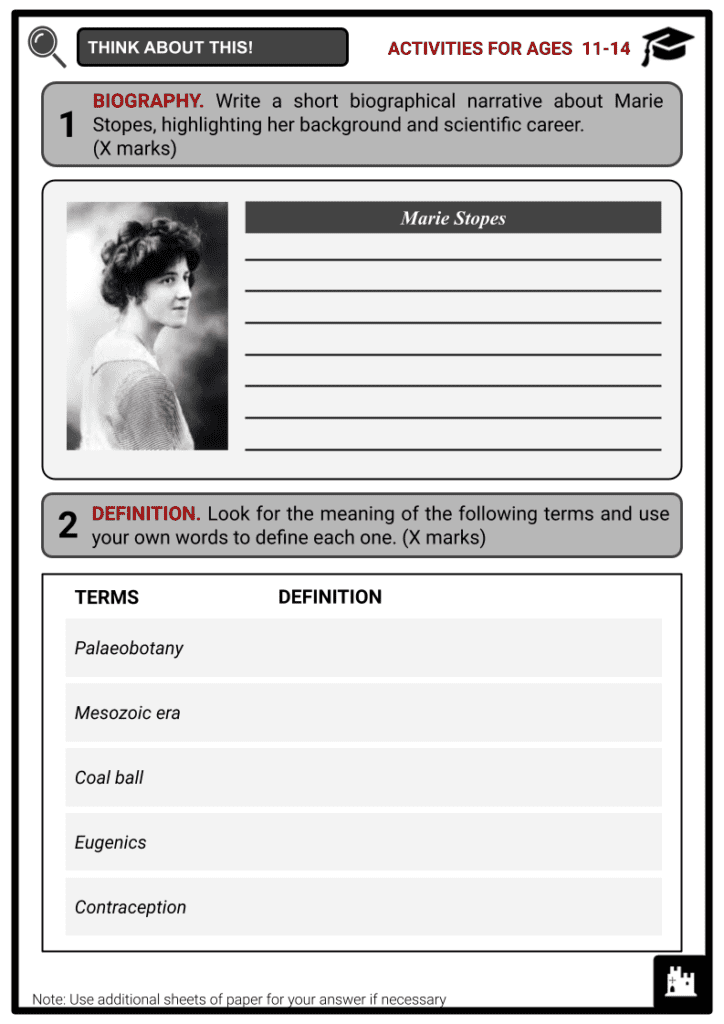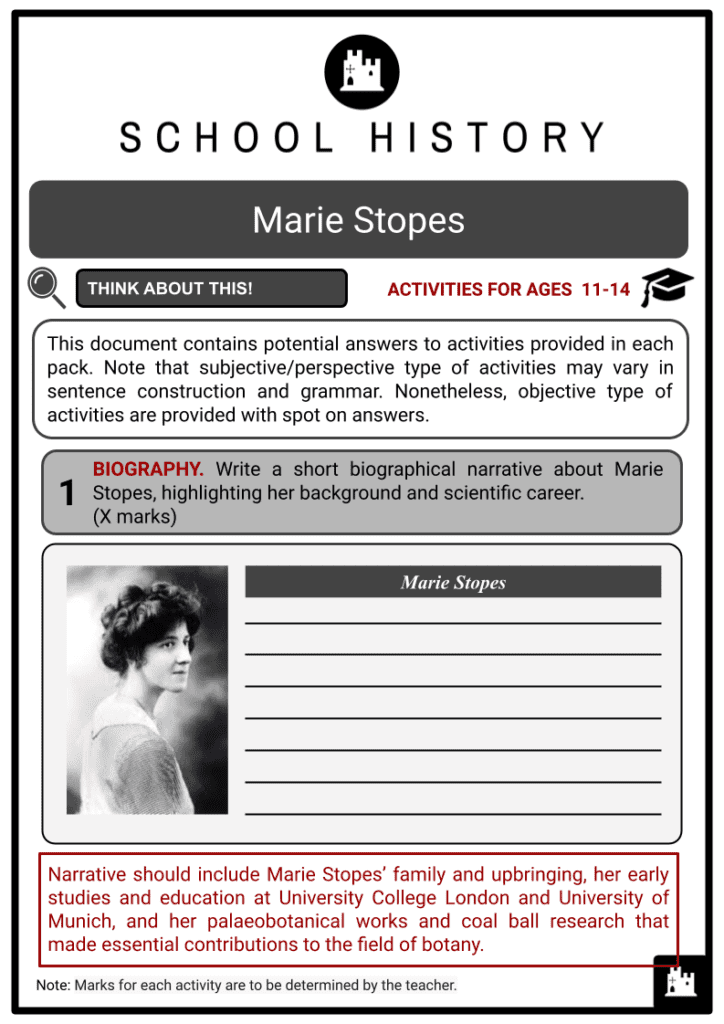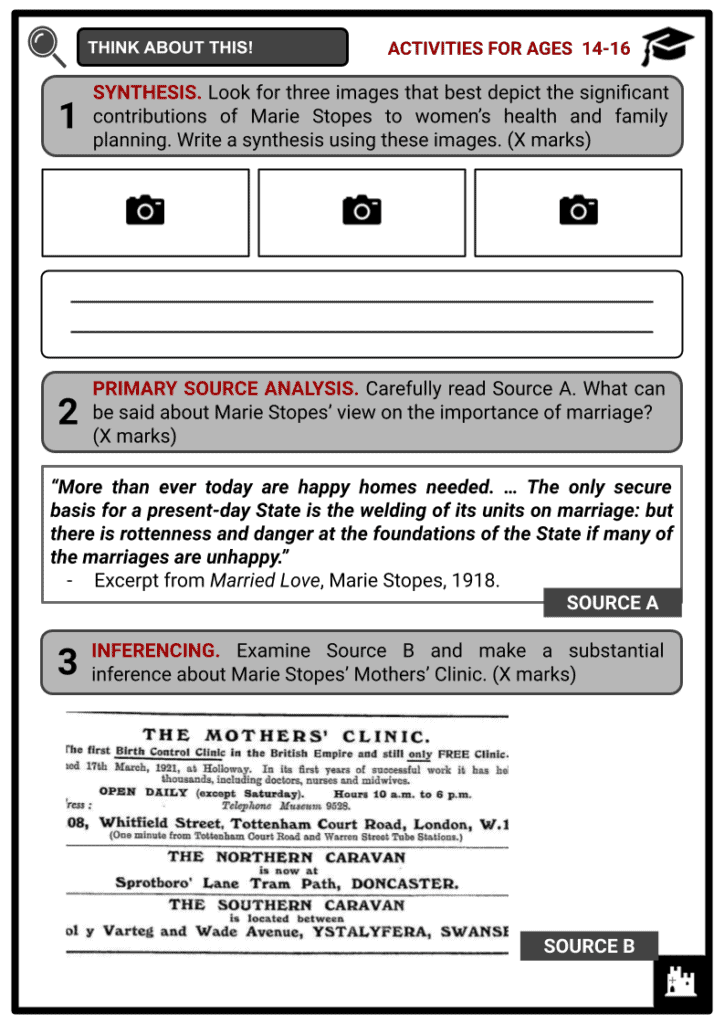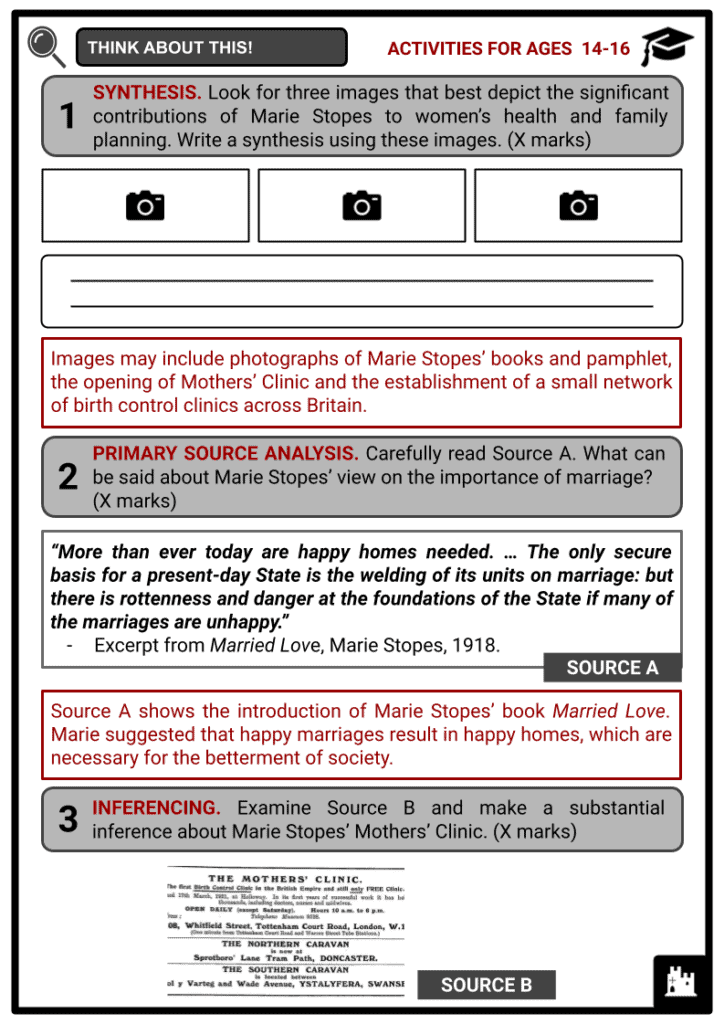Download Marie Stopes Worksheets
Do you want to save dozens of hours in time? Get your evenings and weekends back? Be able to teach about Marie Stopes to your students?
Our worksheet bundle includes a fact file and printable worksheets and student activities. Perfect for both the classroom and homeschooling!
Table of Contents
Add a header to begin generating the table of contents
Summary
- Background and early years
- Palaeobotanical work
- Advocacy and later life
Key Facts And Information
Let’s know more about Marie Stopes!
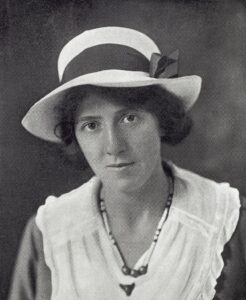
- Born in 1880, Marie Stopes was a British palaeobotanist who made significant contributions to plant palaeontology and coal classification. She campaigned for women’s rights and eugenics, and pioneered work in the area of family planning and sexual health. With her second husband Humphrey Verdon Roe, she opened the first birth control clinic in Britain in March 1921, which was free and open to all married women for education about birth control methods. The Marie Stopes International was formed in 1976, continuing the work she started.
Background and early years
- Born in Scotland on 15 October 1880, Marie Stopes was the daughter of Henry and Charlotte Stopes. At six weeks old, her family moved to England, settling in south-east London.
- Marie’s parents were members of the British Association for the Advancement of Science, allowing her to be exposed to science at a young age and to meet the famous scholars of the day.
- Marie was brought up in a wealthy, educated family: her father was an architect and her mother a Shakespearean scholar and women’s rights advocate.
- She was initially homeschooled and was then sent to St George’s School for Girls in Edinburgh from 1892 to 1894.
- She then attended the North London Collegiate School and obtained a science degree from University College London in 1902.
- The death of her father in 1902 left the family in financial ruin.
- Marie was taken under the wing of her palaeobotany professor, Dr Francis Oliver, who hired her as his research assistant in early 1903.
- This opportunity sparked her interest in palaeobotany, especially given that, at that time, Dr Oliver was on the verge of an important discovery in the field.
- That same year, she was granted the Gilchrist scholarship from University College London with the assistance of her former professors.
- She obtained a doctorate from University College London, becoming the youngest person in Britain to do so.
- She went on to do postgraduate studies in palaeobotany at the University of Munich, where she also earned a doctorate in 1904.
- Also in 1904, Marie became one of the first women to be elected a fellow of the Linnean Society of London.
- She then held the post of lecturer of palaeobotany at the Victoria University of Manchester from 1904 to 1910, becoming the first female academic of that university.
- Additionally, she was a fellow and occasional lecturer in palaeobotany at University College London until 1920.
Palaeobotanical work
- In Manchester, Marie pursued her study of coal balls, influenced by Dr Oliver’s research and driven by the importance of coal to the British Empire as its main source of fuel.
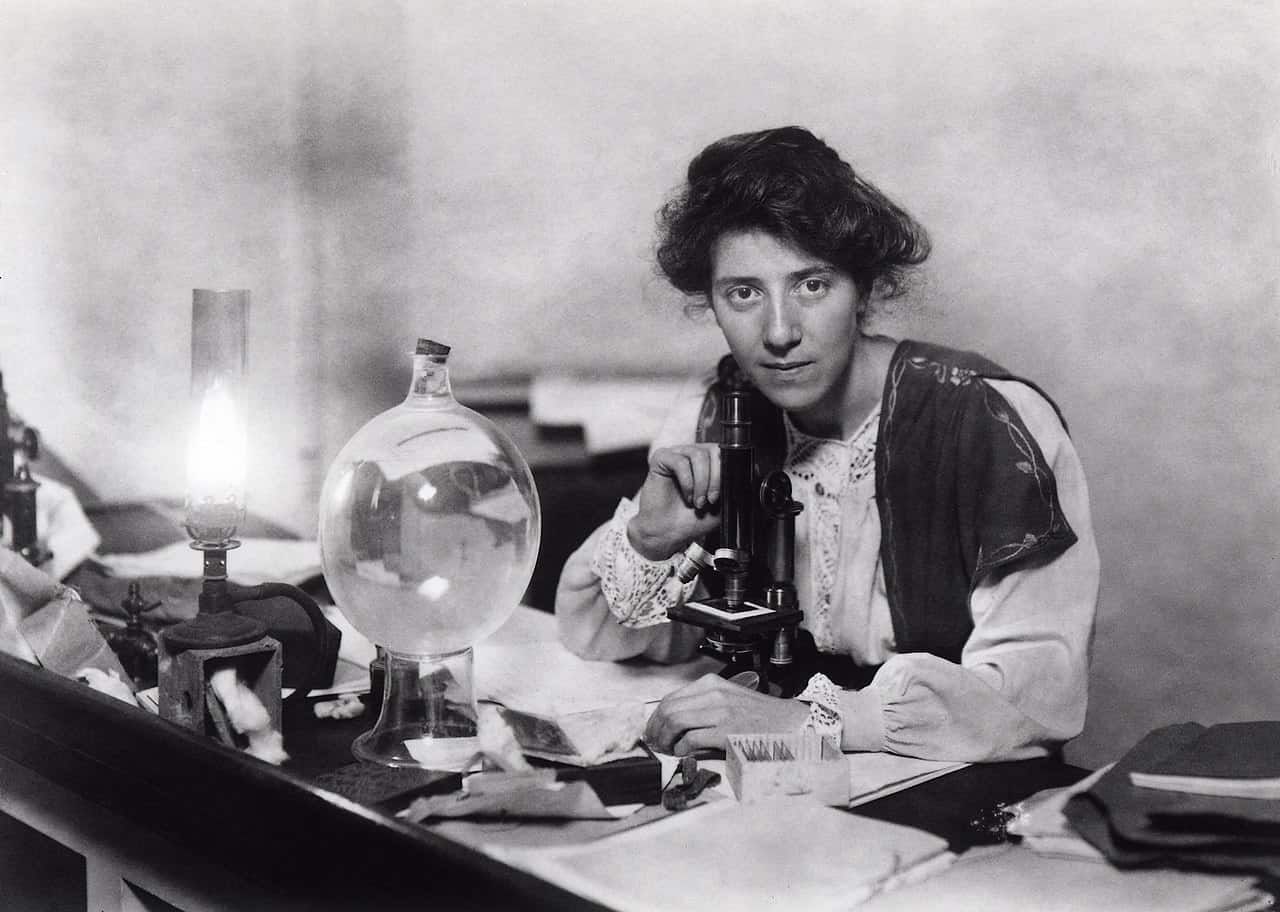
- Continuing her coal ball research, she then extended her studies to include those from the Mesozoic era.
- For this study, she travelled to the coal-mining town of Brora on the Moray Firth in March 1907. She made an interesting finding there despite encountering a setback.
- On her return to Manchester, she began processing her Brora findings for publication.
- At the same time, she successfully secured her first major grant from the Royal Society that would allow her to conduct her research into Mesozoic coal balls in Japan.
- She was able to conclude her Brora research in six weeks and in July 1907, she departed for Japan.
- Marie spent eighteen months at the Imperial University, Tokyo for her study on coal mines in Hokkaido.
- Apart from pursuing her research in Japan, it is widely assumed that part of her motivation for travelling there was to rejoin Kenjiro Fujii.
- Marie first met the Japanese botanist Kenjiro Fujii in Munich in 1906 and developed a relationship with him.
- As with the Brora research, she failed to locate any Mesozoic coal balls in Japan but recorded many important fossils.
- She published her findings in a 1909 article for the Quarterly Journal of the Geological Society, London.
- Additionally, she also wrote a book about her experience of living and working in Japan called A Journal From Japan: A Daily Record of Life as seen by a Scientist in 1910.
- Having returned to Britain in 1909, Marie was then commissioned to do research in Canada by the Geological Survey of Canada.
- Marie arrived in North America in December 1910 and met the Canadian researcher Reginald Ruggles Gates.
- The two became engaged two days after they met and married in March 1911.
- Marie carried out geological field work and researched geological collections in museums, shipping specimens to England for further investigation.
- She concluded her research and the Government of Canada published her results in 1914.
- Later that year, her unhappy marriage to Gates was annulled.
Advocacy and later life
- Marie’s divorce proceedings began in 1913, during which she also started writing a book about marriage inspired by her personal experiences.
- Marie’s book was finished by the end of 1913 but she struggled with having it published: several publishers thought it too controversial.
- In 1917, she found the help that she needed after she was introduced to Humphrey Verdon Roe, a philanthropist interested in birth control.
- Roe paid the Fifield & Co. to publish Marie’s book entitled Married Love.
- Published on 26 March 1918, Married Love, which discussed sex and birth control in the context of marriage, became an instant success.
- Marie married Roe and this marriage provided Marie an opportunity to practise what she wrote in her book.
- Furthermore, the success of her first book about marriage urged her to write a follow-up.
- Her second book entitled Wise Parenthood: a Book for Married People, a manual on birth control, was published later that year. This too was successful.
- In 1919, Marie published the pamphlet A Letter to Working Mothers on how to have healthy children and avoid weakening pregnancies.
- The intended audience of her books had been the middle classes until her pamphlet, a shortened version of her second book aimed at the poor, was produced.
- It was distributed free of charge and was intended to sort out her bias.
- In July 1919, Marie, at the age of 38, gave birth. However, the baby was stillborn.
- After she had sufficiently recovered, she returned to work in 1920, engaging in public speaking and responding to letters seeking advice on marriage, sex and birth control.
- She had her pamphlet disseminated to the slums of East London.
- However, it appeared that the working class was mistrustful of her work. This led Marie to take a different approach to deliver her message to the poor.
- She wrote A New Gospel to All Peoples in 1922, to which both the Anglican bishops and the Catholic Church reacted blatantly.
- At the end of 1920, Marie resigned her lectureship at University College London to focus on opening a birth control clinic.
- She then organised the Society for Constructive Birth Control and Racial Progress, a support organisation for the clinic. This organisation gained prominent supporters.
- Marie and her husband opened the first birth control clinic in Britain called Mothers’ Clinic in Holloway, North London, in March 1921.
- Offering advice and teaching mothers birth control methods, the clinic was supervised by midwives and supported by visiting doctors.
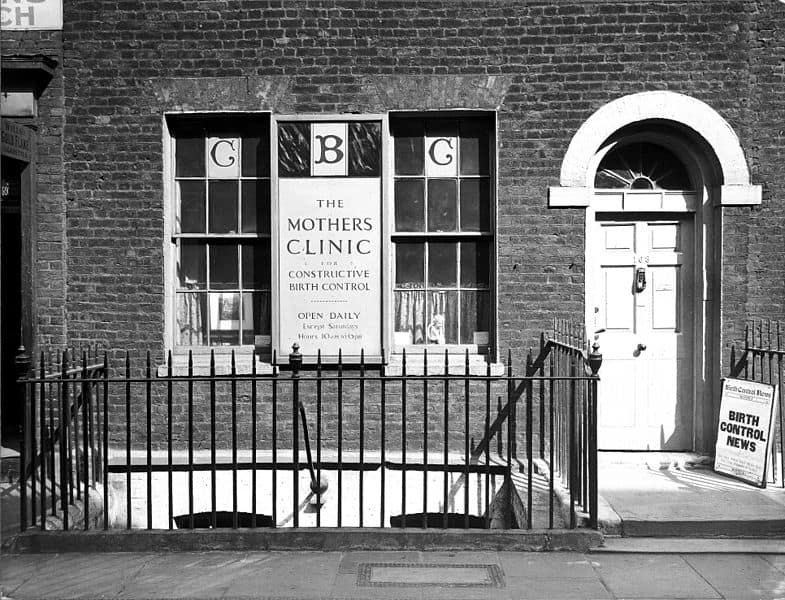
- One of Marie’s contraceptive devices became the centre of the debate in her 1922 libel case against Dr Halliday Sutherland, who condemned her use of ‘harmful’ methods of contraception.
- Marie won only a partial victory but received enormous publicity as a result of the trial.
- In 1925, the Mothers’ Clinic moved to Central London.
- Marie gradually established a small network of clinics across Britain, working to fund them. Between 1934 and 1943, she opened clinics in Leeds, Aberdeen, Belfast, Cardiff and Swansea.
- Whilst her pioneering work in the area of family planning and sexual health deserved much praise, Marie’s support for eugenics made her legacy more complex.
- Like Marie, many prominent thinkers and social reformers of the time supported eugenics or the selection of desired heritable characteristics in order to improve future generations.
- This view of Marie affected her relationship with her only son Harry, who was set to marry a woman with an eye disorder.
- Opposing the engagement, she argued and feared that her grandchildren might inherit the woman’s disorder.
- However, her son was not persuaded and as a result, Marie cut him out of any substantial inheritance.
- On 2 October 1958, Marie, aged 77, died from breast cancer at her home in Surrey.
- She left her clinic to the Eugenics Society whilst most of her estate went to the Royal Society of Literature.
- The clinics she founded continued to operate after her death.
- However, by 1975, the clinics entered voluntary administration due to financial difficulties.
- In 1976, Marie’s organisation was re-founded as Marie Stopes International, working on sexual and reproductive health.
- It has grown steadily and works in 37 countries as of 2019.
- The charity changed its name to MSI Reproductive Choice in November 2020.

